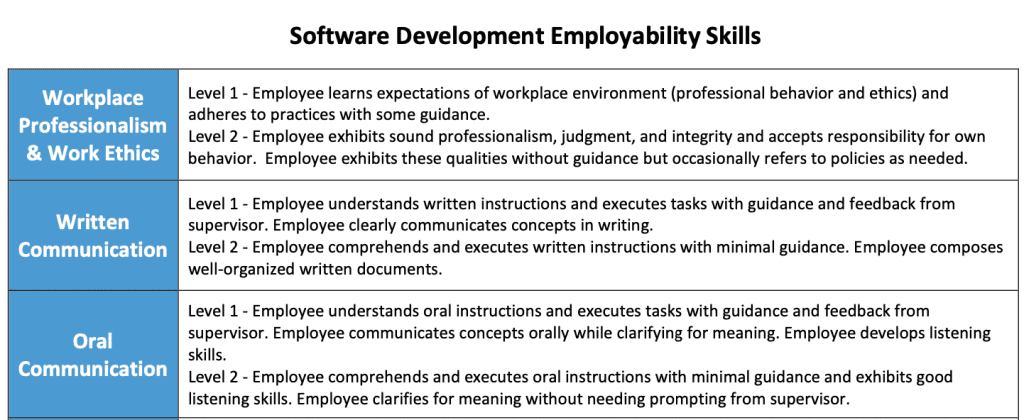The definition for Software Development as developed by approximately 100 Thought Leaders (mostly Chief Technology Officers and Chief Information Officers) through three meetings and follow-up surveys to gain consensus is:
Software Development includes the research, design, secure creation, delivery and quality assurance/testing of computer software and applications including mobile. Additionally, web development can range from developing a simple single static page of plain text to complex web-based internet applications (web apps), and social network services. This definition was adapted from Wikipedia with input from national IT Thought Leaders.
Preview the Software Development Skill Standards below or download the complete Software Development Skill Standards HERE.
*Anyone is welcome to use, modify, and/or distribute ITSS findings and data, but you must give clear attribution to the source of this material by citing “IT Skill Standards 2020 and Beyond (NSF ATE project grant DUE 1838535).”
KSAS
The Tasks, Knowledge, Skills and Abilities (KSAs) were developed with a focus 12 to 36 months in the future for an entry-level employee working in that specific cluster.
More specific definitions can be found within the KSA list.
The average was calculated from the subject matter expert votes.
- A vote of "4" indicated the item must be covered in the curriculum.
- A vote of "3" indicated the item should be covered in the curriculum.
- A vote of "2" indicated that it would be nice for the item to be covered in the curriculum.
- A vote of "1" indicated the item should not be covered in the curriculum.
Task: Specific things an entry level person would be expected to perform on the job with little supervision.
Knowledge: Knowledge focuses on the understanding of concepts. It is theoretical. An individual may have an understanding of a topic or tool or some textbook knowledge of it but have no experience applying it. For example, someone might have read hundreds of articles on health and nutrition, many of them in scientific journals, but that doesn't make that person qualified to dispense advice on nutrition.
Skills: The capabilities or proficiencies developed through training or hands-on experience. Skills are the practical application of theoretical knowledge. Someone can take a course on investing in financial futures, and therefore has knowledge of it. But getting experience in trading these instruments adds skills.
Abilities: Abilities have historically been used to describe the innate traits or talents that a person brings to a task or situation. Many people can learn to negotiate competently by acquiring knowledge about it and practicing the skills it requires. A few are brilliant negotiators because they have the innate ability to persuade. In reality, abilities may be included under skills or may be separated out.

STUDENT LEARNING OUTCOMES
The SLOs are for use in the creation of curriculum to help define what the students will know and be able to demonstrate. Each of these SLOs can be observed, measured, and demonstrated.

KEY PERFORMANCE INDICATORS
Key Performance Indicators answer the question, “How do we know when a task is performed well?”
A search was performed to locate validated/verified KPIs for technician level work in IT fields. Sources included the Texas Skill Standards System, National Skill Standards Board, National Institute of Standards and Technology and other sources. The identified KPIs were then cross-referenced to the tasks for the ITSS 2020 job clusters. They were reviewed and revised by a group of the same subject matter experts who developed the tasks and KSAs for the cluster in a structured, facilitated verification session.

Employability Skills
Employability competencies are essential for every IT job and are based on what the work requires. SMEs were offered three clearly-defined “levels of proficiency” for each employability skill. The proficiency scale is defined as Level 1 – basic; Level 2- intermediate; and Level 3 - advanced. The levels are cumulative, so a “Level 3” assumes the employee can perform all characteristics of “Level 1” and “Level 2.”
For each employability skill, SMEs selected the competency level that best aligned with what would be expected from an entry-level worker for the job cluster in question.
The graphic below presents the level of each employability skill as voted on by the SMEs.

Please submit the form below to receive an email with the Software Development Skill Standards.
Software Development Download Form
"*" indicates required fields
